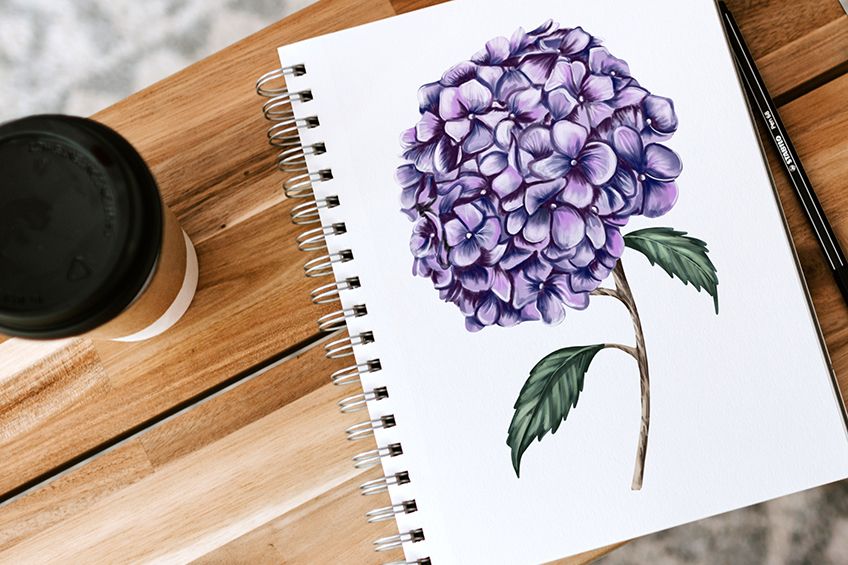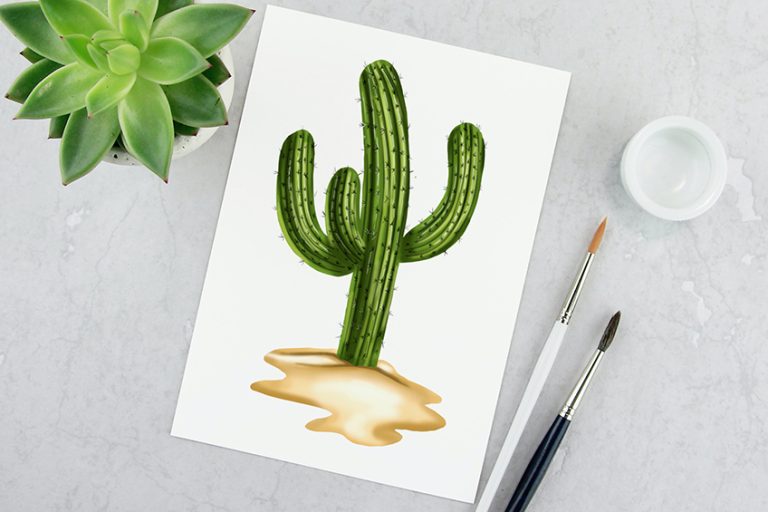How to Draw a Hydrangea – A Realistic Hydrangea Drawing Tutorial
Hydrangeas are beautiful and colorful flowers. These flowers always grow in bunches of small blossoms. One of the most amazing things about hydrangeas is that they can grow in a number of different colors, even on the same bush! In this tutorial, we show you how to construct, outline, and color a realistic hydrangea drawing.
Table of Contents
- 1 An Easy Step-by-Step Hydrangea Drawing Tutorial
- 1.1 Step 1: Create the Base Shape
- 1.2 Step 2: Place the Individual Blossoms of Your Hydrangea Sketch
- 1.3 Step 3: Draw the Center of Your Hydrangea Flowers
- 1.4 Step 4: Draw the Petal Outlines for Your Hydrangea Sketch
- 1.5 Step 5: Shape the Stem of Your Hydrangea Drawing
- 1.6 Step 6: Draw Two Leaves
- 1.7 Step 7: Apply the Base Coat of Color
- 1.8 Step 8: Add Some Color to the Stem of Your Hydrangea Drawing
- 1.9 Step 9: Lightly Color the Hydrangea Leaves
- 1.10 Step 10: Add Some Darker Structure to the Hydrangea Flower
- 1.11 Step 11: Add a Second Color to Your Hydrangea Sketch
- 1.12 Step 12: Blend Your Colors Together
- 1.13 Step 13: Apply Some Highlights
- 1.14 Step 14: Shade the Flowers
- 1.15 Step 15: Define the Contours of the Stem
- 1.16 Step 16: Apply Some Highlights to the Stem
- 1.17 Step 17: Finish the Hydrangea Stem Details
- 1.18 Step 18: Create Structure in the Leaves
- 1.19 Step 19: Soften the Leaves a Little
- 1.20 Step 20: Create Some Leaf Texture
- 1.21 Step 21: Highlight Your Hydrangea Leaves
- 1.22 Step 22: Finalize the Leaf Shading
- 1.23 Step 23: Clean Up Your Easy Hydrangea Drawing
- 2 Our Flower Drawing Tutorials
- 3 Frequently Asked Questions
An Easy Step-by-Step Hydrangea Drawing Tutorial
Although they may seem quite complex at first, this tutorial will show you how to create an easy hydrangea drawing. In order to simplify the process, we begin the hydrangea sketch with a few construction steps. These initial steps will help you to get the shape and dimensions of the hydrangea drawing perfect before you start to add details and colors. You can see an outline of the easy hydrangea drawing in the collage below.

As you can see, color is a very important part of creating this realistic hydrangea drawing. There are a few different decisions that you need to make before we dive into the hydrangea sketch. Firstly, you can decide which color you want your hydrangea drawing to be. These flowers come in various shades of purple, blue, pink, and white. We are going to use purple, but you can pick your favorite! Secondly, you will need to decide which drawing medium you want to use. Our tutorial instructions can be altered to suit any medium, from digital tablets to paint.
Once you have made these decisions, gather your supplies, find somewhere comfortable to sit, and let us begin our easy hydrangea drawing!
Step 1: Create the Base Shape
We begin this hydrangea drawing tutorial by using a single construction shape that will form the general shape of the bunch of flowers. Start by finding the center of your drawing canvas. Then, you can draw a large slightly elongated circle. In the next few steps, we will use this shape to contain the individual hydrangea blossoms.

Step 2: Place the Individual Blossoms of Your Hydrangea Sketch
Now that we have the larger base construction shape laid down, you can use some smaller construction shapes to place the individual hydrangea blossoms. Within the larger oval, and slightly overlapping the right edge, draw several circles of different sizes. These circles can be attached to each other or overlapping.
You can also make the placement of these blossom construction circles as random as possible.
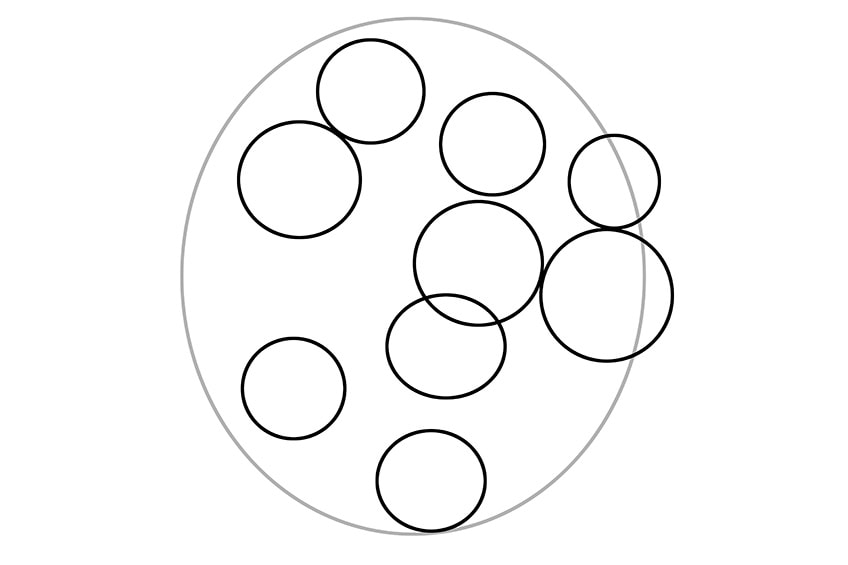
Step 3: Draw the Center of Your Hydrangea Flowers
In this step, you can now begin to add some more detail to these construction lines. Using much smaller circles, you can add some center points to most of the blossom construction circles. These small shapes will determine where we will split flower petals from each other. You can draw a few additional center shapes throughout the larger construction shape, to represent the blossoms that will be only partially visible.

Step 4: Draw the Petal Outlines for Your Hydrangea Sketch
This step is the first really detailed one. Our top tip for this step is to have patience. It is likely to take you some time, but the effort will be completely worth it in your final realistic hydrangea drawing. Using all of the construction lines, start to draw the petals of your hydrangea blossoms. Fill the entire large construction oval with these flower petals.
Each flower should have four petals, and many of them will be overlapping as they are tightly packed together.
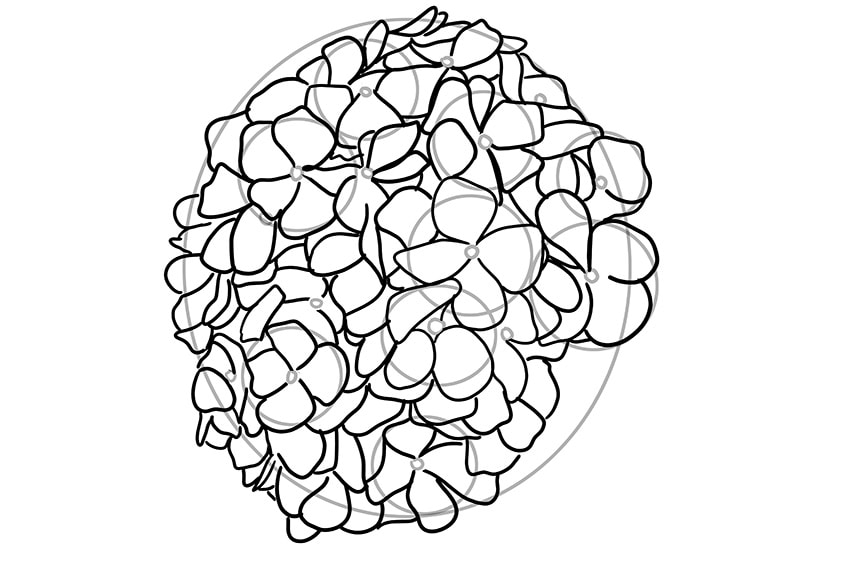
Step 5: Shape the Stem of Your Hydrangea Drawing
Now that the flower bunch is more detailed, you can now draw the stem outline. Begin at the bottom-right edge of the petals, and curve a line down and slightly to the left. On the left side of the stem, draw a small obstructed branch that goes up into the petals, and a second branch just below it.

Step 6: Draw Two Leaves
In this step, you can draw two leaves along the stem of your easy hydrangea drawing. Draw the first leaf on the upper right side of the stem, just where the stem exits the petal bundle. Next, draw the second leaf extending from the lower visible branch, facing the left side. After you have drawn the leaves, you can erase the construction shapes.
Tip: the leaves can be drawn with a downwards curve including on the very tip, to add realistic gravitation.

Step 7: Apply the Base Coat of Color
As we said at the beginning, you are welcome to use any color you wish for the coloring steps. We are using purple, so we begin with a light purple shade of paint. Use a regular paintbrush, and use it to fill the entire blossom shape with an even color coat.
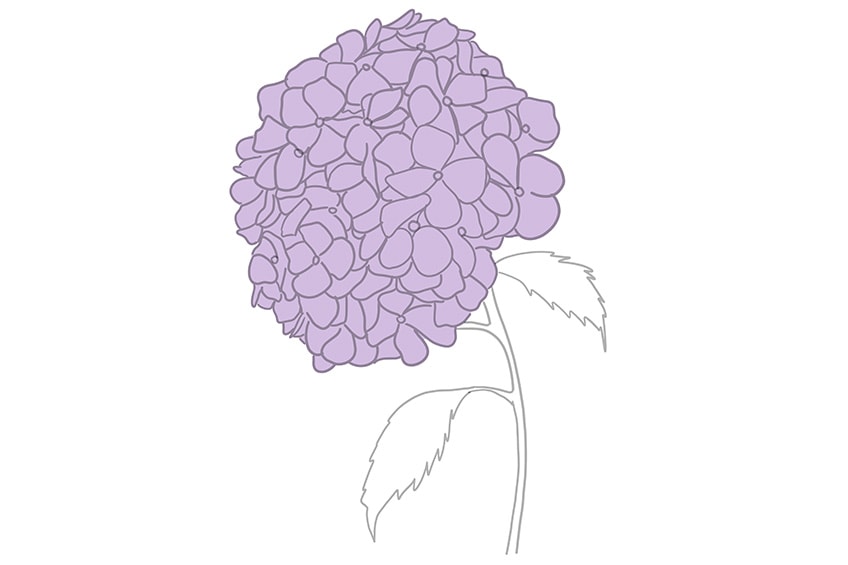
Step 8: Add Some Color to the Stem of Your Hydrangea Drawing
For the stem of the hydrangea sketch, find some light brown paint and a small paintbrush. Use these tools to carefully fill the main stem and the smaller protruding branches.

Step 9: Lightly Color the Hydrangea Leaves
With a normal paintbrush and a shade of pine green paint, apply an even layer of color to both of the leaves of your hydrangea drawing.

Step 10: Add Some Darker Structure to the Hydrangea Flower
Now that you have the base coats for all of the different elements of your hydrangea drawing, you can begin to create some definition. For this step, you will need a very small and soft blending brush and a dark shade of purple paint. Carefully apply light brush strokes on each of the flowers, flowing out from the center onto the petals.
This step will help to separate each flower and create depth in your easy hydrangea drawing.

Step 11: Add a Second Color to Your Hydrangea Sketch
Nothing in nature is simply a single color. To make your realistic hydrangea drawing pop, you will need to include some color variations. You will now need a shade of dark blue paint and the same small blending brush from the previous step. Use these tools to go over the brush strokes from the previous step, leaving the first color coat visible underneath.

Step 12: Blend Your Colors Together
In this step, you are going to use a lighter shade of pink to carefully blend all of the shades of purple and blue together. With a clean blending brush, carefully apply this light pink to each flower, along the edges of each individual petal.
To finish this step and create a smooth blend, use a clean blending brush to smooth all of the colors together.

Step 13: Apply Some Highlights
For this step, you will need a touch of white paint and a small clean blending brush. Carefully apply a touch of highlight to each of the petals, focussing on the edges. Next, with a very sharp paintbrush, create fine hairline strokes of white highlight on each petal. These strokes will help us create some petal texture. Just as you did in the previous step, finish this highlighting process with a clean blending brush and smooth the colors together.
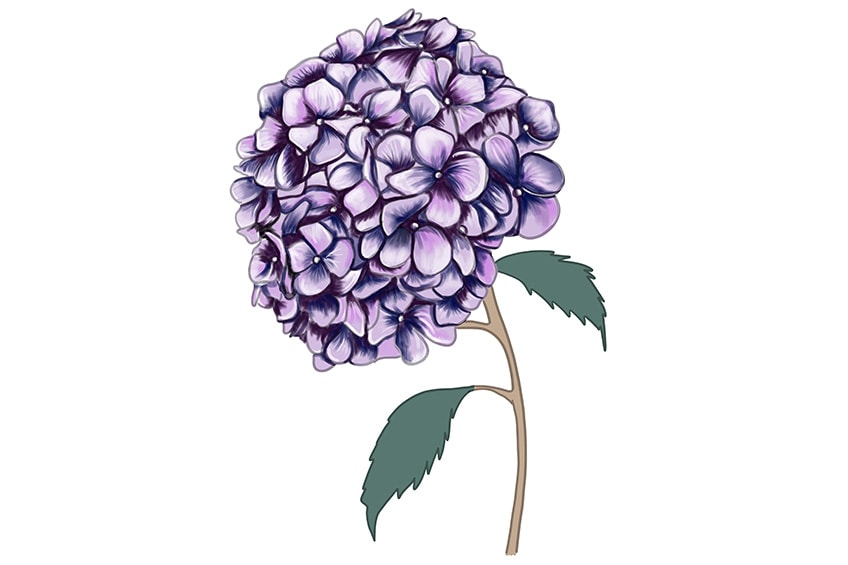
Step 14: Shade the Flowers
Now that you have applied some highlights, we are going to move back to shadows. With a small blending brush and a touch of black paint, carefully add a layer of shading around the edges of each petal. When working with a dark color like black, start off gently. If you need to add more, then you can apply a second layer.
Black is very difficult to remove or paint over, so it is best to take it easy at first.
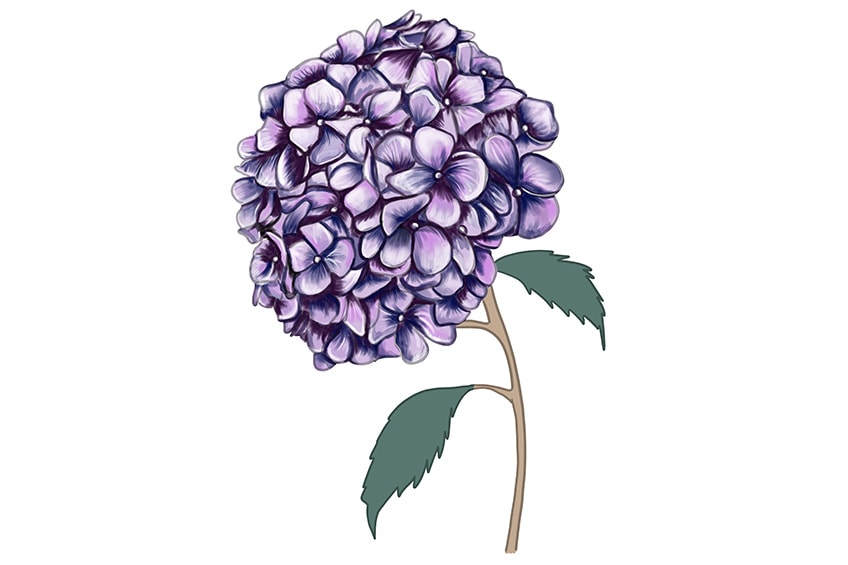
Step 15: Define the Contours of the Stem
For now, we are going to move away from the flowers, and concentrate on the stem and leaves. With a small blending brush and some black paint, carefully apply some light shading around both edges of the stem. Remember to leave the first color coat visible.
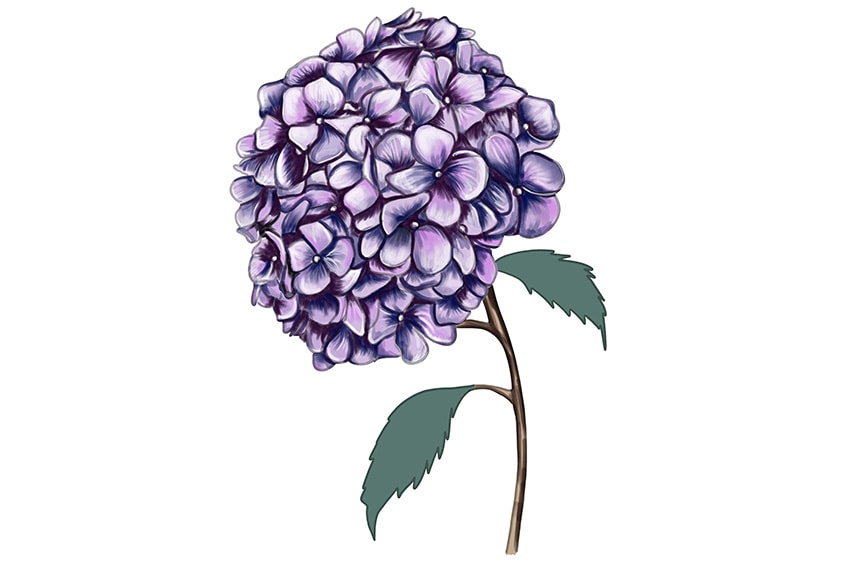
Step 16: Apply Some Highlights to the Stem
To compliment the shading, you can now apply a highlight layer to the stem of your hydrangea sketch. With a small blending brush and some light tan pan, add patches of highlight throughout the center of the stem.

Step 17: Finish the Hydrangea Stem Details
To finish detailing the stem of your hydrangea sketch, you are now going to add some texture lines. With some white paint and a small blending brush, apply some streaks of texture to the stem. You can then repeat this process using some light tan paint.
Tip: To ensure that you create realism, make sure that these brush strokes seem to wrap around the stem with a gentle curve.

Step 18: Create Structure in the Leaves
To begin detailing the leaves of your hydrangea drawing, you will need some black paint and a small blending brush. Lightly shade along the edges and apply a single brush stroke down the center of each leaf. Finally, create some small vein lines on each of the leaves.

Step 19: Soften the Leaves a Little
The shading in the last step was quite harsh, so in this step, you can now soften it slightly. With a clean blending brush and the original pine green color, smooth out the shaded lines from the previous step.
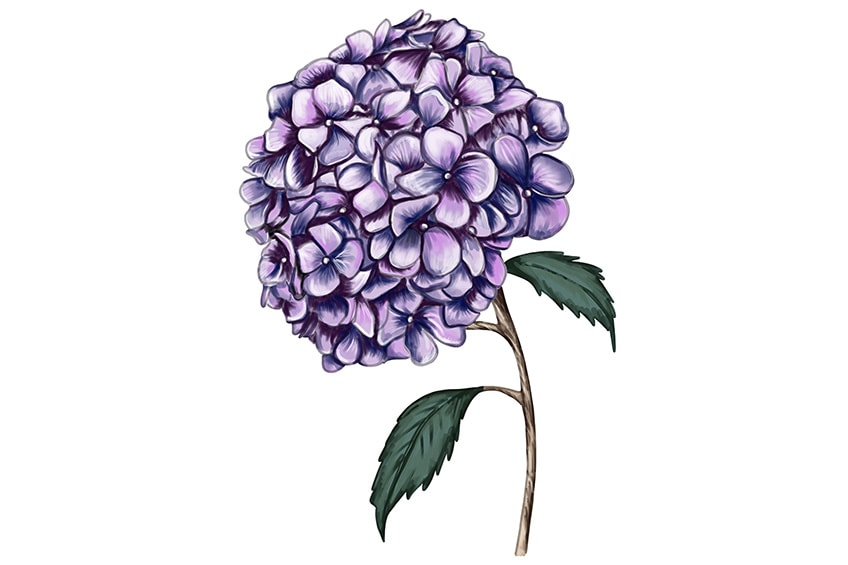
Step 20: Create Some Leaf Texture
For this step, you will need some brighter green paint and a small soft brush. On each of the leaves, apply equally spaced brush strokes from the center to the edges. These lines will emphasize the texture ridges on each of the hydrangea leaves.

Step 21: Highlight Your Hydrangea Leaves
With a small brush and some white paint, carefully apply some strokes of highlight on the tips of each leaf. You can then repeat this process with a fine-tipped brush, adding a highlight stroke along the center line of each leaf.

Step 22: Finalize the Leaf Shading
To finish off the leaves of your hydrangea drawing, use a small blending brush and a very small amount of black paint to softly shade around the edges of each of your leaves.
Be careful not to make this shading too dark and overwhelming.

Step 23: Clean Up Your Easy Hydrangea Drawing
As we come to the end of our tutorial on how to draw a hydrangea, we are going to remove the harsh outlines. Using a very sharp brush and the corresponding color at each point of the outline, carefully trace over the black lines. You can repeat this process for the outlines inside of the realistic hydrangea drawing.
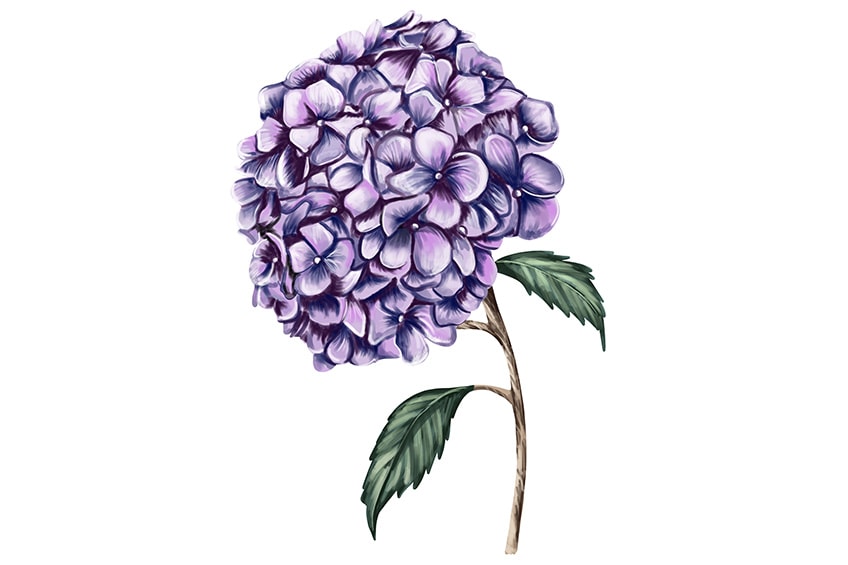
Now you know exactly how to draw a hydrangea flower! Hopefully, you have enjoyed this fun and easy hydrangea drawing tutorial, and you feel more confident in your painting abilities. If you want to create a beautiful flower bouquet, you can take a look at our other flower drawing tutorials.
Our Flower Drawing Tutorials
- Flower Drawing Basics
- Tulip Drawing
- Lily Flower Drawing
- Poppy Flower Drawing
- Orchid Drawing
- Magnolia Flower Drawing
- Hibiscus Flower Drawing
- Calla Lily Drawing
- Lotus Flower Drawing
- Peony Flower Drawing
- Daffodil Drawing
- Dandelion Drawing
- Daisy Flower Drawing
- Sunflower Drawing
- Cherry Blossom Drawing
- Rose Drawing
Frequently Asked Questions
How to Create an Easy Hydrangea Drawing?
It may seem difficult to create a realistic hydrangea drawing as they are quite complex flowers. Fortunately, our tutorial shows you how to create an easy hydrangea drawing in only a few steps. We begin by constructing the general shape of the flower, before creating a more detailed outline of the hydrangea sketch. We then guide you through the process of coloring your hydrangea drawing and creating realistic definition.
How Do You Paint a Hydrangea Sketch?
The painting steps of our hydrangea drawing are the most important when it comes to creating realism. We use a layering process, beginning with a base shade and then adding shading and highlighting to create a realistic perspective.
Matthew Matthysen is an educated multidisciplinary artist and illustrator. He successfully completed his art degree at the University of Witwatersrand in South Africa, majoring in art history and contemporary drawing. The focus of his thesis was to explore the philosophical implications of the macro and micro-universe on the human experience. Matthew uses diverse media, such as written and hands-on components, to explore various approaches that are on the border between philosophy and science.
Matthew organized various exhibitions before and during his years as a student and is still passionate about doing so today. He currently works as a freelance artist and writer in various fields. He also has a permanent position at a renowned online gallery (ArtGazette) where he produces various works on commission. As a freelance artist, he creates several series and successfully sells them to galleries and collectors. He loves to use his work and skills in various fields of interest.
Matthew has been creating drawing and painting tutorials since the relaunch in 2020. Through his involvement with artincontext.org, he has been able to deepen his knowledge of various painting mediums. For example, watercolor techniques, calligraphy and lately digital drawing, which is becoming more and more popular.
Learn more about Matthew Matthysen and the Art in Context Team.
Cite this Article
Matthew, Matthysen, “How to Draw a Hydrangea – A Realistic Hydrangea Drawing Tutorial.” Art in Context. June 1, 2022. URL: https://artincontext.org/how-to-draw-a-hydrangea/
Matthysen, M. (2022, 1 June). How to Draw a Hydrangea – A Realistic Hydrangea Drawing Tutorial. Art in Context. https://artincontext.org/how-to-draw-a-hydrangea/
Matthysen, Matthew. “How to Draw a Hydrangea – A Realistic Hydrangea Drawing Tutorial.” Art in Context, June 1, 2022. https://artincontext.org/how-to-draw-a-hydrangea/.


